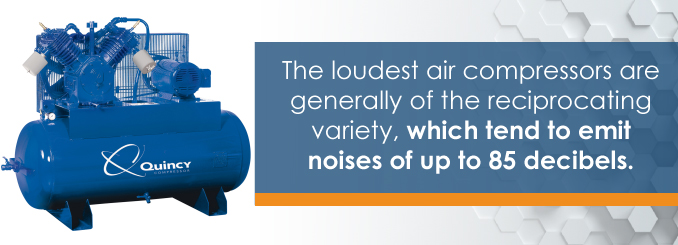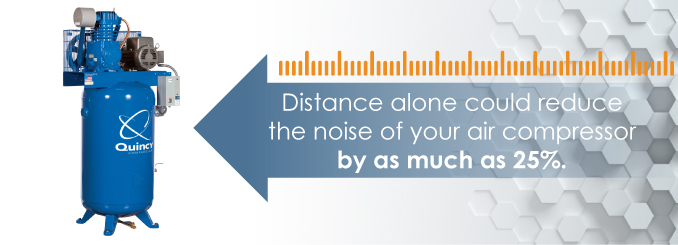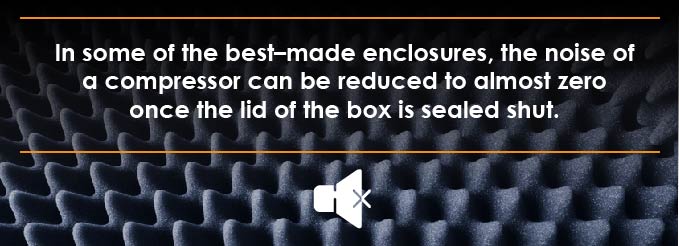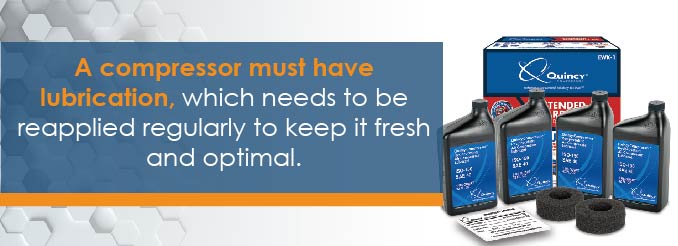Air compressors drive numerous processes across the automotive, canned goods and furnishings sectors. As such, air compressors of various models and sizes work around the clock, minute by minute, hour by hour at factories, manufacturing plants and workshops across North America and around the world. With prolonged operation, compressors can become a source of noise, generating high levels at times. However, much of this can be reduced and even eliminated with the following air compressor sound reduction techniques:
- Install the air compressor in a separate room away from the workspace.
- Maintain a sizable distance between the compressor and workspace.
- Place the compressor in a soundproof enclosure.
- Buffer the compressor’s noise with sound blankets.
As an additional precaution, earplugs offer workers protection when working near and air compressor.

Generally, some of the louder compressors are among the reciprocating variety, which can emit noises of up to 85 decibels. Machines such as these should only be operated in isolated work spaces where there’s a significant noise barrier from surrounding rooms and floors within the same house or building. If weather permits, portable reciprocating air compressors can also be operated outdoors. Rotary screw compressors are generally quieter, because sound–proof enclosures are incorporated into the design. At their loudest, rotary screw units can range from 70 to 75 decibels.
Contact Us Learn More Find a Dealer Near You
Wear Earplugs
Whenever operating an air compressor or any other noisy equipment — lawnmowers, food blenders, vacuums, etc. — it’s wise to wear earplugs to protect your hearing. Even though you might feel as though your ears are tough enough to bear the volume, ears are like eyes. In the same way that vision diminishes somewhat over the course of life, so too does hearing. As with eyesight, the weakening of the ear drum can be accelerated through constant abuse. Therefore, just like you shouldn’t read from a computer screen in a dark room or strain to read small text from far distances, you shouldn’t subject your ears to the amplified noises of loud machinery.
Earplugs are available from a hardware store or an online supplier. Keep these in your pocket at all times when you enter your work area, and stick them in your ears just prior to activating the air compressor. As anyone who now has trouble hearing due to years of noise exposure would tell you, you’re a lucky person if you can’t even fathom what it’s like to experience diminished hearing abilities.
Work at a Distance from the Air Compressor
When operating an air compressor, one of the easiest ways to escape the noise is to keep the machine at a manageable distance from your worksite. Between your garage and driveway, for instance, the machine could be situated in the former as you work outside with pneumatic tools powered via extension hoses. The distance alone could reduce the noise by as much as 25% from your vantage point. The noise could be reduced even further by bringing the garage door down to where it’s just high enough to allow for the passage of cords and hoses.
Granted, the length of hoses may slightly impact air pressure for applications such as painting, which needs a constant flow of air in order to get a consistent finish. The weather will also determine the practicality of working outdoors or indoors. In order to keep a distance from the air compressor while working indoors, consider situating your workspace in the garage with the machine placed across the room. Barring the use of sound blankets or other noise absorbers, it’s common to limit operation to hours when no one else is home.
Place the Compressor in a Soundproof Enclosure
The most effective way to minimize the noise of a smaller, home-use air compressor is to place it inside a soundproof enclosure during times of operation. When cut to the right measurements, an enclosure can be made by hand with the right boards and foaming material. For example, a horizontal portable compressor could be placed inside a handmade box constructed of 12 mm medium density fiberboard. For maximum effect, the walls should be double–plated for a total board thickness of 24 mm, in addition to a layer of inner–padding consisting of convoluted foam board.
When constructing an enclosure for your air compressor, be sure to take note of the inlet valve and tool hoses, as each will need holes through which to operate. An optimal enclosure design would include a cutout panel in the back to account for the power cord and atmospheric–air needs of the machine. In some of the best–made enclosures, the noise of a compressor can be reduced to almost zero once the lid of the box is sealed shut.
With the noise of an air compressor significantly reduced or nearly eliminated during each operation, a lot more work can generally be accomplished, especially if other people are involved in a given project. In a workshop setting, for instance, the reduced noise levels allow you to hear your work colleagues as each application is applied with the tools that connect to the machine. If someone has a question that pertains to the work at hand, the answer can be given as you demonstrate, the compressor won’t have to be shut off in order for you and your coworkers to hear one another.
Wrap the Compressor in Sound Blankets
While the use of a soundproof enclosure is the most effective way to eliminate compressor noise, the roaring decibels can still be adequately reduced with the use of sound blankets, which muffle volume by absorbing the high and mid–range frequencies. When draped across walls within an area that contains a compressor or other loud piece of machinery, the frequencies are comfortably reduced for those on the outside. As such, sound blankets have become a popular anti–noise aid in home recording studios and band rehearsal spaces, where amplification is absorbed by the blanket fibers and thus blocked from other parts of the house and — more importantly — the ears of neighbors.
With air compressors, sound blankets can be used in several different ways to absorb noise, especially from the noisiest part of the machine: the piston cylinder. One way to use sound blankets is by placing them on the inside of a two–sided enclosure that consists of two walls hinged together at a 45° angle. Place the compressor in the far–back corner of your garage, and seal the area off with the blanket–buffered enclosure. This should reduce sound to a level that will barely register with anyone in your living, or for that matter people in other houses nearby. The two–sided enclosure method is good for both portable and stationary compressors.
Another way to seal off compressor noise with sound blankets is by placing the machine inside a large cabinet or box, and then draping the blanket over the outside. For example, a small horizontal compressor could be sat down inside a box or even a chest with the blanket placed down over the top and sides like a tablecloth. Within a sizable cabinet, a portable compressor could be placed in side with the blanket draped over the closed door.
***It is important to note that the exhaust from gas-driven unites should never be trapped in any of these setups.
Sound blankets can also be placed directly on top or around the edges of an air compressor. On large, square, stationary units, a blanket can be draped over the machine in much the same way that you’d drape a box or chest, provided that the inlet valve, cords and hoses aren’t obstructed by the cloth. Sound cloth can even be physically wrapped around the noisiest parts of an air compressor. On scroll and reciprocating air compressors, the cylinders can be wrapped with acoustical fiberglass insulation, which can be cut and stitched to snuggly fit.
Even though these kinds of setups won’t induce the silence of a soundproof enclosure, sound blankets can buffer the lawnmower–like noise of a compressor down to a level more akin to a dishwasher or laundry machine. When used at a distance or with earplugs, sound blankets can render compressor noises harmless to even the most sensitive–hearing user.
Perform Maintenance at Regular Intervals
An air compressor endures a lot of grueling heat and motion as it sucks atmospheric air through the inlet, compresses the air with a piston and stores it in the tank as energy. Consequently, a compressor generates lots of noise throughout its operation. As the mechanisms are put through the motions, certain parts within the machine can gradually wear and grind. As time goes on, the resulting noise can increase as the machine works harder to keep up with the demands of each application. In effect, the noise of an air compressor feeds into itself and gets worse as things go along. Unless, that is, you keep the compressor’s busiest parts maintained on a regular basis.
Lubricate the air compressor
Air compressors, like all machines, consist of metal parts that move around and rub against each other. In order for these parts to continue moving so that the compressor can function as wanted, lubrication must be present around the joints and bearings at all times. Without lubrication, the metals will grind, corrode and weaken, all of which will place strain on the system and eventually wear the compressor down. As all of this happens, the compressor will strain harder and harder to maintain the level of performance it once did, and make increased amounts of noise in the process. Therefore, a compressor must have lubrication, which needs to be reapplied regularly to keep it fresh and optimal.
Keep the air filters clean
On air compressors, the air filter traps airborne dirt particles that get sucked in through the inlet valve. The purpose is to keep the cylinders dirt free. However, a filter can only trap so much dirt before it must be unclogged to start anew. If the filter is left clogged, the system strains to operate as atmospheric air gets blocked from passing into the cylinders, while at the same time stray dirt particles starts wandering through. As the problem gets worse, the compressor will make more and more noise. Ideally, the inlet filters should be cleared out every 12 months or less, depending on operating conditions.
Have your compressor maintenanced by a professional
With proper maintenance, you could add years to the life of your air compressor. While some of the simpler maintenance tasks like lubricating and filtering can be performed by the average owner, there are certain tasks that are best handled by a trained service professional. Every year or so, contact a nearby service center to have parts examined and performance analyzed. Compressor parts such as belts, gaskets and valve plates need to be replaced now and then, so do check to see whether it’s time for new ones. A telltale sign that a compressor is overdue for a maintenance checkup is when it becomes noisier than usual.
Choose a Quality Air Compressor
In factories, manufacturing, workshops and garages, air compressor sound reduction is a vital concern for everyone involved. Noise is not only distracting, it can also slow workflow by making it difficult for a work crew to communicate during an ongoing application. While it’s smart to apply air compressor noise suppressor methods, it’s also important for machines to undergo maintenance on a regular basis. Most crucial of all, however, is the quality of the air compressor at hand.
For more than 90 years, Quincy Compressor has been at the forefront of air compressor technology. Both domestically and abroad, we’ve provided top–quality air compressors to companies and craftspeople that use pneumatic power for everything from furniture production and auto work to painting, drilling and nailing. Over the decades, our vast inventory of air compressors and tools has earned us a global reputation for innovation, reliability and durability.
Regardless of the size or scope of your operation, you too can accomplish dozens of tasks — painting, nailing, drilling, sawing, screwing, sanding and more — with the power of an air compressor. To learn more about Quincy’s portable and stationary compressors, head over to our products and sales service page today.
Contact Us Learn More Find a Dealer Near You





